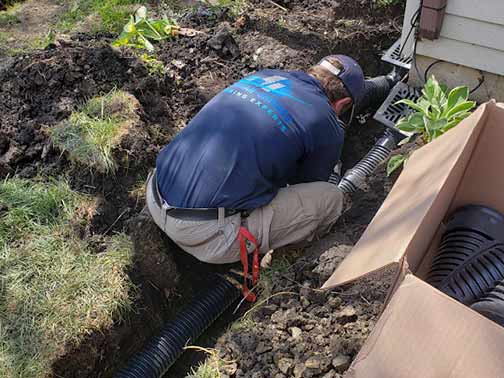
Downspouts, heavy rainfall, improper ground slope and other factors can cause water to collect at the base of your home. If this water is allowed to stay in place, it can seep into the foundation of your building and increase the risk of foundation damage. If this does not happen, TrustArt Property Management warns that water can destroy your plant bed and impair the home’s curb appeal.
Here we discuss the four ways you can direct water away from the base of your house to solve this problem and protect your investment.
Increase the ground slope
Water always flows from high to low ground. If water is pooling at the base of your home instead of flowing away from it, it could be because the ground around the house is lower than the surrounding areas. It is possible that this is due to the house settling lower than the adjacent areas. It could also be because of erosion.
The easy and quick way to solve this problem is to increase the slope of the ground. Add enough dirt around the home to create a gentle slope. You may not need to do it around the entire house but only in areas where water collects. When doing this, do not use clay soils; they don’t drain well and will only compound your problems.
Use granular soil with high soil content; you can buy those from a home improvement store. For the best results, you want the slope to extend 2-3 feet from your house. The soil should slope at about 1 inch (2.5 cm) per 1 foot (0.30 m). Pack the soil firmly and add seed grass to prevent erosion.
Use gutters and downspouts
Under normal conditions, rainfall from your roof will drip directly into your home’s foundation. But gutters catch the water and direct it into the downspout. But even with this, water can still pool at the base of your house if the downspout is not discharging water in the right place on the property.
If the downspout is allowed to discharge its water at the point where it reaches the ground, it can cause water to pool around the house. Especially in areas where expansive clay soils are prevalent, this can be a huge problem. The soil’s tendency to hold massive amounts of water can cause problems for homeowners.
There are two ways to keep water from collecting at the base of your house when the problem is from the downspout. You can use rain barrels or a rainwater collection system to catch water from the downspout. Another way is to install downspout extensions; these are extendable and let you direct the water where you want it.
Install a French drain
A French drain is a below-ground drainage system that collects water from the soil around your home and moves it to a safe location on the property. The French drain consists of a trench filled with gravel with perforated pipe and geotextile fabric. Water that collects on the ground above the French drain will soak into the soil before seeping through the gravel bed and eventually into the pipe.
The trench should be around 4-6 feet from the foundation of the house, at least 6 inches wide, 24 inches deep, and it should extend to the lowest area of your yard. A French drain can also be installed to discharge water into existing storm drains. In order for a French drain to work effectively, it must have an adequate slope.
Unlike the other two solutions above, you may need permits from the city to install a French drain on your property. Before having a French drain installed, make sure the planned drain has the capacity to handle the rainfall in your area. You do not want the system to overflow because it is overwhelmed by the amount of runoff from your home.
Install a swale
A swale is a large depression in your yard where water can go. This solution is for you if you have serious issues with water pooling around the base of your house. It requires less maintenance than a French drain. However, a swale can alter the appearance of your yard; hence it must be done in a way that enhances the property’s appeal.
There are two types of swales you can install in your home. A wet swale is used in areas with heavy rainfall and is often filled with aquatic plants. A dry swale is always dry and can be decorated with various plant species to make it attractive. Note that proper sloping is a requirement when installing a swale since the water is pulled into the depression under the force of gravity.
Which of these four solutions is proper for your home? It depends on what is causing water to pool around the base of the house, the ground slope around your home and your location.

